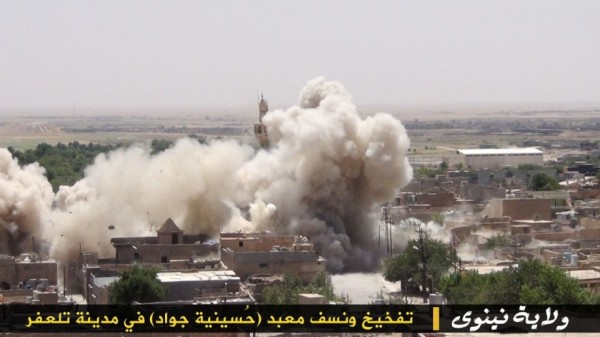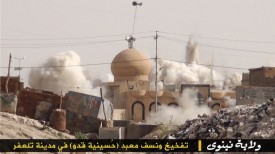Mass Destruction of Islamic Cultural Heritage Sites in Iraq
In the past few days, pictures have been posted online which make it clear that the Islamic State in Iraq and Syria (ISIS) has engaged in widespread destruction of shrines and graves related to Shia Islam.
While initial fears since the fall of Mosul nearly a month ago focused on the threat to Assyrian monuments and archaeological sites, it appears that the Shia are viewed as a more pressing threat to ISIS.
By destroying Shia holy sites, ISIS hopes to erase Shia culture from the regions they control and also provoke a response from Iraq’s Shia, which will in turn drive more Sunnis to supporting ISIS.
UPDATE 3/16/2015: The American School of Oriental Research has obtained satellite photographs of the area around Tal Afar which confirms the destructions reported in this post. Read the full report here.
Shrine of Sheikh Fathi – Mosul
Last week, ISIS attempted to destroy the shrine of Sheikh Fathi but where prevented by local citizens who surrounded the shrine and threw rocks at them until they left. It appears that ISIS returned in the middle of the night with a bulldozer and at least seriously damaged the structure.
The current shrine was built in 1760, but seems to contain mihrabs from the 13th century.
The Tomb of the Girl – Mosul
-

Tomb of the Girl in an undated photograph. (Source)
Local popular legend holds that the Qabr al-Bint or Tomb of the Girl is the tomb of a beautiful girl who died of a broken heart. Historians believe the tomb, which sat in the middle of the street in Mosul, is in fact the tomb of the noted 12th-13th century medieval historian Ali Ibn al-Athir, who traveled with Saladin in Syria and wrote a history of the Islamic world from the Crusades to the Mongol invasions.
The tomb sat in the middle of Ibn al-Athir Street in Mosul until ISIS fighters pulverized it with a bulldozer last month.
Fortunately, it seems that the tombstone situated in the outdoor shrine is a modern replica and the original was long ago removed to the safety of a museum.
Ibn al-Athir was a Sunni, and shows that ISIS is not only targeting Shia sites for political reasons but also any graves that could be viewed as shrines. The destruction is not only political but also theological.
Tombs of Ahmad ar-Rifa’i and Sheikh Ibrahim – Muhallabiyah
Photos published by ISIS show the destruction of a building in the tiny town of Muhallabiyah, southeast of Tall Afar, labeled “Tomb and shrine of Ahmed ar-Rifa’i.” Ahmed ar-Rifa’i was a Sufi mystic and philosopher (died 1183) and founder of the Rifa’i order of Sufi mysticism. ISIS and other Wahabi and Salafist Muslims view Sufism as a heresy.

More photos show the destruction of another building in Muhallabiyah labeled “Shrine and grave of Sheikh Ibrahim.” I have been unable to learn any other information about this monument. There is a village named Sheikh Ibrahim near Muhallabiyah, as well as a neighboring mountain.
Shia Mosques – Tal Afar
The city of Tal Afar, 35 miles west of Mosul, is almost entirely populated by Iraq’s Turkmen minority, a quarter of whom are Shia. Since capturing Tal Afar, ISIS has reportedly kidnapped forty Shia Turkmen and driven 950 from their homes.
On June 25 and 26, the attackers blew up several of Tal Afar’s Shia mosques, as documented in a series of photographs shown below.
The Shia Sheikh Jawad Mosque in Tal Afar was rigged with explosives and destroyed. It had previously been attacked by suicide bombers in 2008.
The Qaddo Mosque, the Mosque of Imam Saad bin Aqeel and the Mosque of the Martyr of Lashkar-e-Mulla were also destroyed:
ISIS identified each mosque as a “Temple of Hussein.” Certain Shia mosques used for ceremonies in remembrance of Hussein Ibn Ali‘s death on October 13, 680 at the Battle of Karbala are called Husseinias, however ISIS’ use of the term appears to be to condemn them as idolatrous pagan structures.
A number of other mosques have been reported destroyed in Tal Afar. A report from Human Rights Watch lists the Mosques of Imam Sadiq, al-Abbas, Ar-Mahmoud, Ahl al-Beit and Hashim Antr as destroyed. Another from Shafaq News states that the Mosque of al-Hakim has also been destroyed. I must admit that I am not well versed enough in the region’s architecture to know if any of these are different names for the structures depicted above.
ISIS in Tal Afar have also destroyed smaller shrines. Images have been published of the destruction of the Shrine of Arnaout (or ar-Mamut). I cannot find any more information about this structure:
The Human Rights Watch article also mentions the destruction of a shrine of Khidr al-Elias in Tal Afar which is revered by Shia Muslims, Christians and Yezidis. Khidr is a figure in Shia and Sufi Islam often associated with Elias/Elijah. Shrines to a combined “Khidr Elias” have been venerated all throughout Mesopotamia.
Shia Mosques – Mosul
Footage has been released of a small Shia mosque in Mosul being destroyed. Squibbing around the minaret shows that the structure appears have been rigged with demolition charges in a carefully planned fashion.
Future Plans
ISIS has threatened to attack Najaf and Karbala and destroy the ancient Shia mosques there. According to ISIS spokesman Abu Muhammad al-Adnani, “These differences go back a long way. We will settle our differences not in Samarra or Baghdad, but in Karbala, the filth-ridden city, and in Najaf, the city of polytheism.”
The al-Askari Shrine in Samarra was destroyed in 2006, an event which triggered massive sectarian violence in Iraq. The shrine, originally built in 944, is the burial place of the Tenth and Eleventh Shia Imams, and adjacent to it is the spot where the Twelfth Imam allegedly disappeared in 874. It has been rebuilt. Last week ISIS attacked it again with mortar fire.
Najaf is home to the Shrine of Ali, the burial place of Ali Ibn Abi Talib, the fourth Islamic Caliph who is revered by the Shia as the rightful successor to Muhammad. Karbala contains the Shrine of Hussein, built over the grave of Ali’s son Hussein who was buried there after he was killed in the Battle of Karbala. Both structures were built in 979-980 AD.
Some ISIS members have gone even further in their threats to Islamic sites. ISIS member Abu Turab al-Mugaddasi said on Twitter last week that “If Allah wills, we will kill those who worship stones in Mecca and destroy the Kaaba. People go to Mecca to touch the stones, not for Allah.” One can hope that publicizing ISIS’s destruction of Islamic history will dissuade Sunnis from supporting ISIS who may be considering doing so.
























Trackbacks